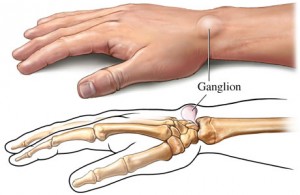What is Ganglion of the Wrist?
A ganglion of the wrist is a small non-cancerous fluid filled sac that usually develops in the wrist. In most cases these cysts are harmless. These cysts can quickly appear, disappear or change size.
Ganglion cysts are commonly round or oval and are filled with a thick jelly-like fluid. Some ganglion cysts can be of the size of a pea and some can be around an inch in diameter.
Ganglion cysts mostly affect people in the age range of 15 to 40 years and women are more likely to get affected than men.
Symptoms of Ganglion of the Wrist
Ganglion cysts are mostly found along the tendons or joints of your wrists or hands. They are commonly found on the palm side of the wrist, near the base of a finger or near an end joint of a finger.
Ganglion cysts are usually painless but sometimes they can cause pain or muscle weakness.
Some cysts are so small they are barely noticeable. They often fluctuate in size when the joint is used for repetitive motions.
How is Ganglion of the Wrist diagnosed
During the diagnosis the doctor may apply pressure to the cyst to check for tenderness or discomfort. He or she may shine a light through it to confirm whether it is a thick solid mass or filled with jelly-like fluid.
The doctor might also advise you to perform tests like X-rays, ultrasound or magnetic resonance imaging ( MRI ) to eliminate conditions such as arthritis, tumor or cancer. MRIs and ultrasounds can also detect hidden cysts known as occult cysts.
Aspiration, a process in which your doctor uses a needle and syringe to draw out the fluid in the cyst can confirm the presence of a ganglion cyst. Fluid from a ganglion cyst can be either thick and clear or translucent.
Treatment for Ganglion of the Wrist
In most cases these ganglion cysts are painless requiring no treatment and they frequently disappear spontaneously.
If these cysts are painful or limit your activity several treatment options are available.
The use of splints and anti-inflammatory medication can be effective in order to decrease pain associated with movement.
An aspiration can be performed to drain the fluid from the cyst and decompress it. This requires placing a needle into the cyst, which can be performed in most of the clinics in Singapore. Aspiration is a very simple medical process, but recurrence of the cyst is common. If non-surgical options fail to be effective, surgical alternatives are available.
Surgery involves getting rid of the cyst along with a portion of the joint capsule or tendon sheath. In the case of ganglion cysts on the wrist, both traditional open and arthroscopic techniques usually yield good results. Treatment via surgery is generally successful although cysts may recur. Your surgeon can advise the best treatment options available for you.
Home remedies
An old home remedy for a ganglion cyst consisted of “thumping” the cyst with a heavy object such as a book. However this kind of treatment is now discouraged.
Also never try to “pop” the cyst yourself by puncturing it with a needle. This method is most likely to be ineffective and can lead to infection.
Consultation for Ganglion of the Wrist in Singapore
We at Singapore Sports and Orthopaedic Clinic, conveniently located at Gleneagles Medical Centre, Central Part of Singapore provide treatment for ganglion of the wrist so please feel free to contact us. We provide same day appointment and Xray / MRI prior advanced arrangement. Our specialists have 20+ years of experience. Also e-filing facility is available at our clinic.






